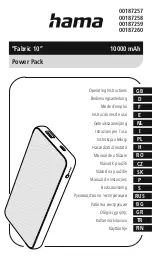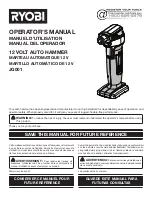
8
ETIQUETAS DE AVISO
AVISO
EL HACER CASO OMISO DE LOS AVISOS SIGUIENTES PODRÍA OCASIONAR LESIONES.
ADVERTENCIA
Las herramientas neumáticas
pueden vibrar durante el uso.
La vibración, los movimientos
repetitivos o las posiciones
incómodas podrían dañarle los
brazos y las manos. En caso
de incomodidad, sensación de
hormigueo o dolor, dejar de
usar la herramienta. Consultar
al médico antes de volver a uti-
lizarla.
No coger la herramienta
por la manguera para le-
vantarla.
ADVERTENCIA
Mantener una postura del cuerpo
equilibrada y firme. No estirar de-
masiado los brazos al manejar la
herramienta.
Manejar la herramienta a una
presión de aire máxima de 90
psig (6,2 bar/620 kPa).
90 psig
(6.2bar/620kPa)
Cortar siempre el suministro
de aire y desconectar la man-
guera de suministro de aire
antes de instalar, retirar o ajus-
tar cualquier accesorio de esta
herramienta, o antes de realizar
cualquier operación de man-
tenimiento de la misma.
No utilizar mangueras de aire
y accesorios dañados, des-
gastados ni deteriorados.
ADVERTENCIA
ADVERTENCIA
ADVERTENCIA
ADVERTENCIA
ADVERTENCIA
ADVERTENCIA
Use siempre protección ocular
cuando utilice esta herramienta
o realice operaciones de
mantenimiento en la misma.
Use siempre protección para
los oídos cuando utilice esta
herramienta.
AJUSTES
AJUSTE DE PAR
Para ajustar el par de estas llaves de impulso de doble
paleta, proceda como sigue:
1. Saque el tapón del orificio de ajuste.
2. Gire el eje de accionamiento hasta que se pueda ver el
tornillo de ajuste de par a través del orificio. El tornillo
de ajuste de par no tiene pintura de color en el hueco
de la cabeza.
3. Con una llave hexagonal de 2 mm, gire el tornillo de
ajuste a la derecha para incrementar el par y a la
izquierda para disminuirlo. No gire el tapón de aceite.
NOTA
Haga todos los ajustes finales donde está trabajando.
4. Vuelva a colocar el tapón del orificio de ajuste.
CAMBIO DEL LÍQUIDO DEL MECANISMO
Para cambiar el líquido del mecanismo de impulso, proceda
como sigue:
1.
Utilice una llave hexagonal para quitar los tres tornillos
y arandelas de la carcasa de la maza. Saque la carcasa
de la maza de la carcasa del motor por encima del eje
de accionamiento. Retire la junta de la carcasa de la
maza.
2.
Retire el mecanismo armado del rotor.
3.
Utilice una llave hexagonal de 2,5 mm para
desenroscar el tapón de aceite. Saque el retén del tapón
y el soporte del retén.
4.
Utilice la llave hexagonal de 2 mm provista con la
herramienta para girar en sentido antihorario hasta el
tope el tornillo de ajuste que no tiene pintura en el
hueco de la cabeza.
5.
Con el orificio para el tapón de aceite hacia abajo sobre
un recipiente, gire el eje de accionamiento para purgar
el líquido del mecanismo.
6.
Con la jeringuilla y el líquido del kit de cambio de
líquido (pieza nº EQ106S–K400), llene de líquido el
mecanismo hasta que rebose por el orificio de llenado.
Para el modelo 1100PS4 se necesitarán 17 cc de
líquido y para el modelo 1900PS4 30 cc. (véase el
esquema TPD1265).
NOTA
NO SUSTITUYA NINGÚN OTRO LÍQUIDO.
Si no se usa el líquido suministrado, se podría dañar la
herramienta, incrementar los cuidados de
mantenimiento que requiere y reducir el rendimiento.
Use solamente líquido limpio en estas herramientas.
(Esq. TPD1265)
Summary of Contents for 1100PS4 Series
Page 13: ...MAINTENANCE SECTION 13 Dwg TPA1480 ...
Page 22: ...22 NOTES ...
Page 23: ...23 NOTES ...









































